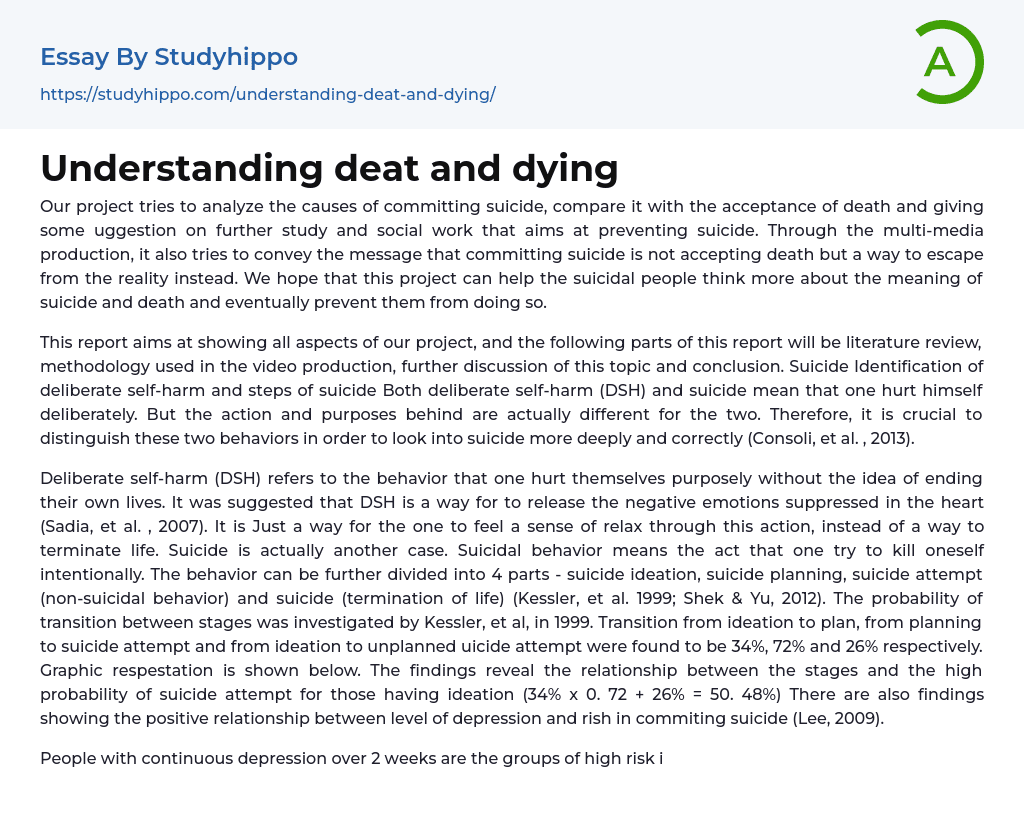Our project concentrates on examining the reasons behind suicide and contrasting it with the acceptance of death. We provide suggestions for further research and social work endeavors in order to prevent suicide. Our multimedia production aims to convey that suicide is not a means of accepting death, but rather an effort to escape from reality. Through this project, we aspire to encourage individuals who are contemplating suicide to reflect on the importance of both suicide and death, ultimately dissuading them from pursuing such actions.
This report will cover various aspects of our project, such as conducting a literature review, outlining the methodology used in video production, further discussing the topic, and presenting a conclusion. Our primary emphasis will be on suicide identification, deliberate self-harm (DSH), and the steps involved in suicide.
Differentiating between deli
...berate self-harm and suicide is crucial as they both involve intentionally harming oneself. This distinction is necessary to obtain a more comprehensive and precise understanding of suicide (Consoli et al., 2013).
Deliberate self-harm (DSH) is intentionally hurting oneself without the intention of ending one's life, serving as a way to release suppressed negative emotions (Sadia, et al., 2007). It provides relaxation rather than being a means for suicide. Suicide, however, refers to the deliberate act of attempting to kill oneself and can be categorized into four parts: suicide ideation, suicide planning, non-suicidal behavior (suicide attempt), and termination of life (suicide) (Kessler, et al., 1999; Shek ; Yu, 2012). Kessler et al. investigated the transition between these stages in 1999. The probability of transitioning from ideation to planning, planning to attempt, and ideation to unplanned attempt were found to be 34%, 72%
and 26% respectively. The graph below illustrates these findings by revealing that individuals experiencing ideation have a strong likelihood of attempting suicide (34% x 0.72 + 26% = 50.48%). Moreover, there are findings indicating a positive relationship between the level of depression and the risk of committing suicide (Lee, 2009).
People who experience depression for over two weeks are highly likely to engage in suicidal behavior. The process leading to suicide begins with the development of negative emotions caused by challenging circumstances in their lives. These individuals may try to suppress their feelings as a strategy to ease their concerns, which is one form of mental control. Alternatively, they may resort to self-harming (DSH) as a means of obtaining temporary relief from stress and regaining a sense of control when overwhelmed by their ongoing depression.
If the situation worsens, people may lose hope in resolving their problems and DSH (Deliberate Self-Harm) may no longer be effective in providing comfort. Consequently, they might develop thoughts of suicide and potentially choose to end their lives as a means of escaping their harsh reality. Sociologist Emile Durkheim classified suicides into three categories. The first category is egoistic suicides, where individuals cannot effectively integrate into society.
The text discusses three types of suicides: egoistic suicides, altruistic suicides, and anomic suicides. Egoistic suicides occur when individuals feel disconnected from society. Altruistic suicides are committed by people who sacrifice themselves for the betterment of society. Anomic suicides occur in unstable societies where individuals lack a sense of belonging (Comer, 1998). In Hong Kong, suicide cases and deliberate self-harm (DSH) have become significant causes of adolescent mortality, surpassing diseases and starvation. This
trend is particularly apparent in affluent regions like America, Japan, and Hong Kong (Shek and Yu, 2012).
- Anatomy and Physiology essays
- Addiction essays
- Biodegradation essays
- Dental Care essays
- Disease essays
- Disorders essays
- Health Care essays
- Intelligence Quotient essays
- Nutrition essays
- Olfaction essays
- Public Health essays
- Women's Health essays
- World health organization essays
- Cancer essays
- Infectious Disease essays
- Lung Cancer essays
- Neurology essays
- Physical Exercise essays
- Medicine essays
- Sex essays
- Inquiry essays
- Disability essays
- Poison essays
- Action Potential essays
- Nervous System essays
- Childbirth essays
- Puberty essays
- Blood essays
- Kidney essays
- Neuron essays
- Body essays
- Glucose essays
- Sense essays
- Heart essays
- Skeleton essays
- Human Physiology essays
- Eye essays
- Immune System essays
- Muscle essays
- Skin essays
- Brain essays
- Central Nervous System essays
- Human Skin Color essays
- Digestive System essays
- Common sense essays
- Respiration essays
- alcoholism essays
- Smoking essays
- Casino essays
- Tobacco essays




